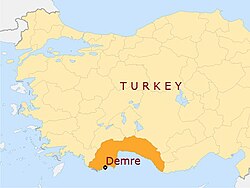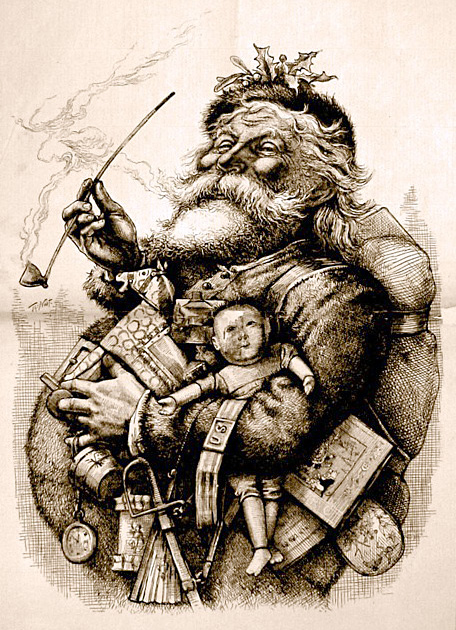
The REAL Saint Nicholas – of Myra – “saved three innocents from death.” (“Inter alia…”)
* * * *
 Aside from the ongoing Season of Advent – from December 3 to 24 – there’s another Feast day to celebrate in early December. Wednesday, December 6, was the Feast day for the REAL “Jolly Ol’ Saint Nick.” He was Saint Nicholas of Myra, and he lived from 270 to 340 A.D. So when Dr. Philip O’Hanlon told his daughter Virginia – at left – “Yes, there is a Santa Claus,” he was telling the truth.
Aside from the ongoing Season of Advent – from December 3 to 24 – there’s another Feast day to celebrate in early December. Wednesday, December 6, was the Feast day for the REAL “Jolly Ol’ Saint Nick.” He was Saint Nicholas of Myra, and he lived from 270 to 340 A.D. So when Dr. Philip O’Hanlon told his daughter Virginia – at left – “Yes, there is a Santa Claus,” he was telling the truth.
Or at least the truth as that term is defined in today’s politics.
But seriously, on December 6 each year Nicholas of Myra is celebrated as a friend of children, giver of gifts and climber of chimneys. (“Etc.”) And as noted in the painting atop the page, he was brave enough to “save three innocents from death.”
Nicholas was visiting a remote part of his diocese [when he heard of the “three innocents.” He set out for home and] found a large crowd of people and the three men kneeling with their arms bound, awaiting the fatal blow. Nicholas passed through the crowd, took the sword from the executioner’s hands and threw it to the ground, then ordered that the condemned men be freed from their bonds. His authority was such that the executioner left his sword where it fell…
 Incidentally, the three innocent men had been sentenced to death by the ruler of Myra – today’s city of Demre, Turkey – “the corrupt prefect Eustathios [who] had accepted bribes to bring about the deaths of three men.” This first St. Nicholas “was not one to be intimidated by the power of others, especially the power of the corrupt.” He “stormed into the prefect’s office and demanded that the charges against the three men be dropped.”
Incidentally, the three innocent men had been sentenced to death by the ruler of Myra – today’s city of Demre, Turkey – “the corrupt prefect Eustathios [who] had accepted bribes to bring about the deaths of three men.” This first St. Nicholas “was not one to be intimidated by the power of others, especially the power of the corrupt.” He “stormed into the prefect’s office and demanded that the charges against the three men be dropped.”
That corrupt official eventually “confessed his sin and sought the saint’s forgiveness. Nicholas absolved him, but only after the ruler had undergone a period of repentance.”
Which leads to this thought: “Boy, we could sure use him today!!!”
Then there were the stories of Nicholas of Myra’s “love for God and for his neighbor:”
The best-known story involves a man with three unmarried daughters, and not enough money to provide them with suitable dowries. This meant that they could not marry, and were likely to end up as prostitutes. [This was in “the good old days.”] Nicholas walked by the man’s house on three successive nights, and each time threw a bag of gold in through a window (or … in colder climates, down the chimney). Thus, the daughters were saved from a life of shame, and all got married and lived happily ever after.
 Another story was more gruesome, but also had a happy ending. During a time of famine, a butcher “lured three little children into his house, where he killed them, placing their remains in a barrel to cure, planning to sell them off as ham.” But Nicholas of Myra both “saw through the butcher’s horrific crime” and resurrected the three children from the barrel.
Another story was more gruesome, but also had a happy ending. During a time of famine, a butcher “lured three little children into his house, where he killed them, placing their remains in a barrel to cure, planning to sell them off as ham.” But Nicholas of Myra both “saw through the butcher’s horrific crime” and resurrected the three children from the barrel.
And it was from that “first St. Nicholas” that the jolly old elf at right evolved from. (Even if some stories about him may lessen your appetite for pickled goods this holiday season…)
But then there’s the question: “Why do we celebrate Christmas on December 25, if St. Nicholas Day is December 6?” There are a number of theories, but the most reasonable says that December 25 is nine months after March 25, by tradition the date of The Annunciation. (I.e., the date of the “announcement by the angel Gabriel to the Virgin Mary that she would conceive and become the mother of Jesus, the Son of God.” See On the Original St. Nicholas.)
You can see more at St. Nicholas [the] Saint Who Stopped an Execution, and Celebrating St. Nicholas: the Story of the Three Condemned Innocents. Or from this blog, On the REAL “Jolly Ol’ Saint Nick,” and On St. Nick and “Doubting Thomas…”
* * * *
The upper image is courtesy of Saint Nicholas – Wikipedia, the free encyclopedia, with the caption: “Saint Nicholas Saves Three Innocents from Death (oil painting by Ilya Repin, 1888, State Russian Museum).” See also St. Nicholas Center … Saint Who Stopped an Execution, and saint nicholas church st nicholas church is the most outstanding … tourmakerturkey.com, which added: “The protective personality of St. Nicholas and desire of helping children in difficult situations have been transformed into a sympathetic old Santa Claus … appearing on Christmas Eve to make everybody happy.”
* * * *